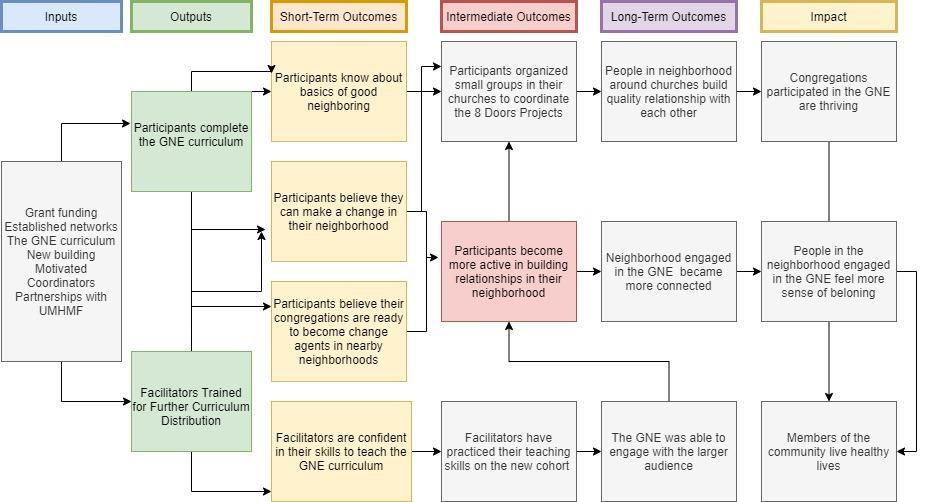
3 minute read
Conclusion and Recommendations
participants reported spending more hours building relationship than those in Kansas. Here is some important data to keep in mind:
• Knowledge: The more knowledge participants gained, the higher their level of comfort with working in small church groups was. 5 Changes in knowledge were not related to changes in attitudes or neighboring behaviors based on the data we have available.
Advertisement
• Knowing Neighbors by Name: If participants knew more neighbors’ names after the GNE program, they were more likely to report having more acquaintances after completing the curriculum. 6
• Having acquaintances: The more acquaintances participants gained, the more people they reported having relationships with in their neighborhood.7 These findings suggest that there is a pathway for building relationships from simply knowing someone’s name, to knowing about who they are, and what their strengths are to making deeper connections with them.
• Positive trends in knowledge, attitudes, and comfort: The findings here suggest that knowledge being imparted through the GNE program is successfully being translated to participants. In terms of attitudes, it seems as though many participants start the GNE program with very positive attitudes related to their readiness to make change, perceptions of their potential to be good neighbors, and feelings of hope for the future of their churches. Due to this high baseline, the changes were quite modest. This finding suggests that efforts should be made to recruit participants who, perhaps, are not quite as ready to change or are not yet able to see their potential to be good neighbors or hope for the future of their churches. Findings also indicated positive trends in participants’ comfort levels with small group work within their churches. However, the Mark Cohort (a facilitator only group) showed a larger improvement in comfort level than the Exodus Cohort. This finding indicates that perhaps some elements of the facilitator-only curriculum can be useful to be used into other cohorts unless you suspect that the facilitator only groups are pre-selected in a way that makes them more comfortable to work in small groups within their churches. • Future focus on energizing congregations: Because the GNE is designed to impact large systems like neighborhoods and communities through building the capacities of change agents, including congregation members and churches, further attention to their roles as change agents is warranted. While overall, those who completed the GNE curriculum show positive attitudes towards their neighborhood change-maker
5 R= .514, p=.007 6 R=.691, p=.001 7 R=.685, p=.029
roles, reportedly, the same does not apply to other members of their congregations or churches as a whole. Participants were skeptical of their congregation's energy levels and relationships that their churches currently have with surrounding neighborhoods. These findings might imply several things: o The curriculum may have larger effects on individual attitudes and motivations than on congregations’ dynamics. o COVID-19 may have prevented the curriculum and individual knowledge from trickling down to enact organizational shifts within churches. o Future efforts might be focused specifically on what is happening in small groups within churches. o Re-energizing and/or motivating congregations might be a separate task that needs to be monitored. It may be worthwhile to consider adding elements to the curriculum aimed at building participants’ capacities to motivate the broader populations within their churches. • Neighboring events are consistently an area where the respondents are either having a hard time responding, are unaware of events taking place, or do not attend. While it might not be the largest part of the GNE curriculum, opportunities to spend quality time with the neighbors can boost other indicators being measured in the evaluation as well as create opportunities for sustainable relationships. It may be worthwhile to re-consider what roles neighboring events play in the curriculum. • Participants in different age groups seem to experience levels of knowledge gains. It might be useful to reflect on whether the online mode of delivery has some impact on it and whether certain modes of delivery work better for some age groups versus others. • Considering the significant number of participants residing out-of-state, it is important to pay attention to how well the program is designed to serve those completing it remotely. Preliminary findings suggest that local Kansas participants do better when it comes to achieving the program outcomes. It might be the case that some additional components should be introduced to the out-of-state participants. For example, these components could include face-to-face residencies in Kansas or internship programs with successful neighboring initiatives.



